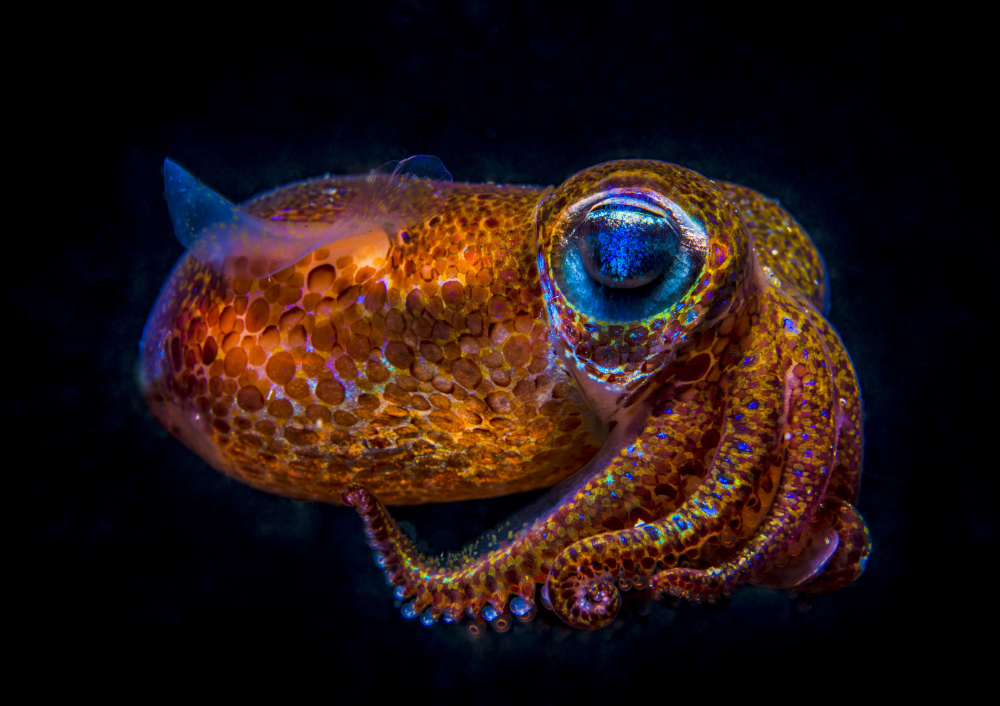
Diving at night is in itself a very different situation compared to daytime diving. Even in the same dive site there can be sensational changes between day and night.
In the Mediterranean Sea, in particular, a sandy-muddy substrate can transform during the hours of darkness from a desert expanse to a crowded apartment building.
This is the case, for example, of one of the diving spots I mostly frequent, both during the summer and winter, the Cala di Puolo in Massa Lubrense.
We are, in fact, in Italy, more specifically in Campania, in the province of Naples, in the Sorrentine Peninsula.
In this bay, both in summer and in winter, it is possible to make beautiful night dives, thanks to the great wealth of species present in this site of the Gulf of Naples. By virtue of this faunal richness, it is no coincidence that in Naples there is the seat of the historic Anthon Dohrn Zoological Station.
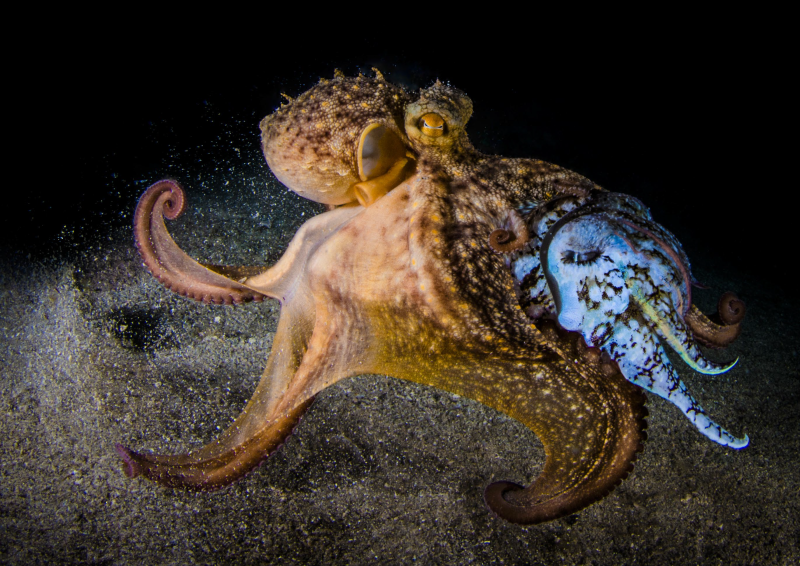
The dive site is located inside the Marine Protected Area of Punta Campanella and is available for divers under accompaniment from authorized diving centers, while local divers, gathered in small groups, have the opportunity to dive independently in B and C zones of the marine park, on payment of an annual fee.
Usually I dive in Puolo making use of the collaboration with my reference diving center, the Punta Campanella Diving Center, located in Marina della Lobra in Massa Lubrense.
The diving center is very popular within underwater photographers and is therefore UW Photographers Friendly – that is open to satisfy the thousands of needs of its underwater photographers guests, who are not always welcome due to the different needs compared to divers without a camera.
In fact, where possible, the choice of dive sites is shared, but a longer and calm time for the shot is also supported. There is also the possibility of rinsing the camera separately from other equipment, to avoid any damage to them.
When the weather is favorable, we usually wait for darkness to fall before leaving the embarkation dock. Our experience confirms that it is always better to wait for the evening to “mature” to allow the creatures of the night to populate the sandy desert which is not very frequented during the day.
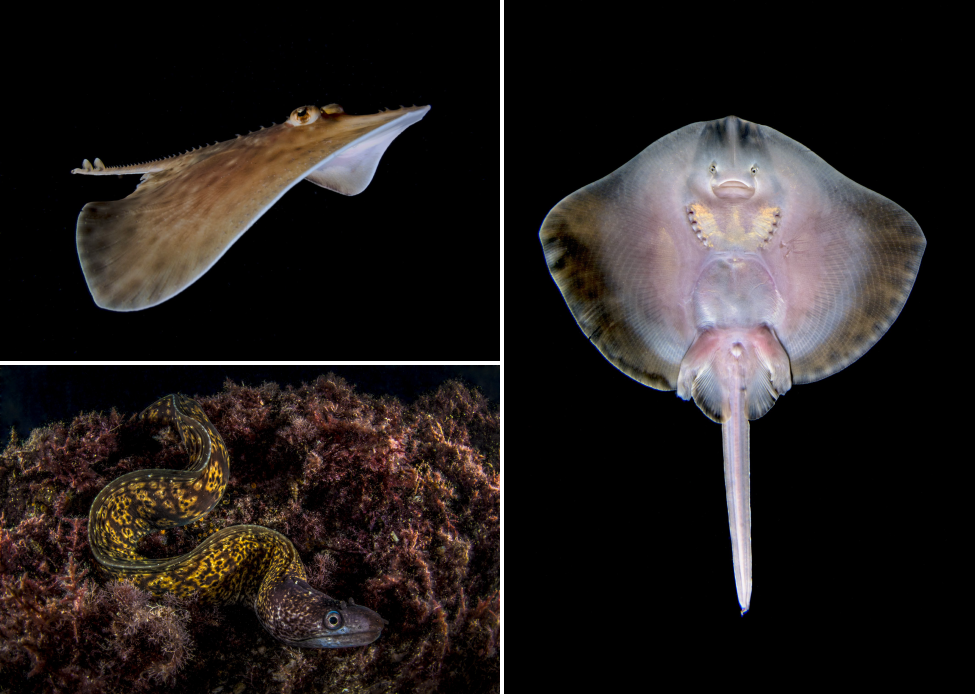
The dive begins in the center of the bay, in the shape of a mirrored J. On the sides there are rocky walls while in the center of the bay, starting from the beach, we first find large pebbles and boulders at about 8 meters deep, which around 15 meters deep turn into gravel, where a Posidonia oceanica meadows has settled up. Going deeper, along the slope that leads to over 50 meters, the gravel turns into sand with some more muddy areas.
This is precisely the most interesting area, where we immediately go in search of subjects. During the night, in fact, all the inhabitants hidden under the sand come out of the substrate, but at the same time they come out in search of food, both prey and nocturnal predators.
Thus it is possible to meet dozens of very interesting subjects who make diving in this site something almost always worth to remember.
On the sand, in fact, we immediately findsome small eel fish, Ariosoma balearicum, the lizard fish with sharp jaws, ready to catch some fish while they are buried in the sediment.
Common is also the encounter with the mullets Mullus surmuletus and Mullus barbatus, in addition to the two-banded sea bream Diplodus vulgaris, the picarels Spicara maena and Spicara smaris, but also with the red porgy Pagrus pagrus and the common pandora Pagellus erythrinus.

After having moved away from the rocky dens found along the walls of Cala di Puolo, it is also possible to meet some moray eels Muraena helena and conger Conger conger, caught hunting on the bottom. On the rocks rising from the bottom, you can meet one of the most beautiful anthozoans of all, the Alicia mirabilis, a nocturnal anemone that shows all its beauty as soon as it is illuminated by the lamps.
After a few moments, in fact, the animal retracts its beautiful and long tentacles that uses as a net to capture its prey, and begins to retract them by twisting them, creating beautiful transparent coils. In order to avoid this and be able to photograph without disturbing it, it is necessary to turn on the red focus light and be careful not to lift up the inevitable dust that the photographer raises when approaching.
It is fairly common to meet some cuttlefish Sepia officinalis, the tiny Sepiola rondeleti, some common octopus Octopus vulgaris, but also some less frequent species such as the Octopus macropus and the rare sand octopus Octopus dephilipii. In truth, those who are the most sought-after subjects are others … in particular, on the sandy expanse below 40 meters of depth, it is common to meet above all one of the most beautiful fish by far, my favorite subject, the John Dory a.k.a. Zeus faber.
Its shapes are unmistakable and its charm remains unchanged despite I met and photographed it hundreds of times in over 45 years of diving.
Usually it can be seen from afar, asleep near the bottom, then under our powerful lamps it starts to set in motion and usually begins its descent towards greater depths. Knowing its habits, however, we know well that it is necessary to circumvent and approach it from below to bring it to moving towards the surface.
Normally, it starts swimming in the water column and you can photograph it for a long time if not annoyed. Yet, it will always turn its tail towards the camera lens.
With experience, one learns to anticipate its movements to being able to intercept it when it changes direction, with its angular face facing the camera. However, it often happens that the fish is faster than the photographer, who’s left to watch as it swims away to over 50 meters deep.
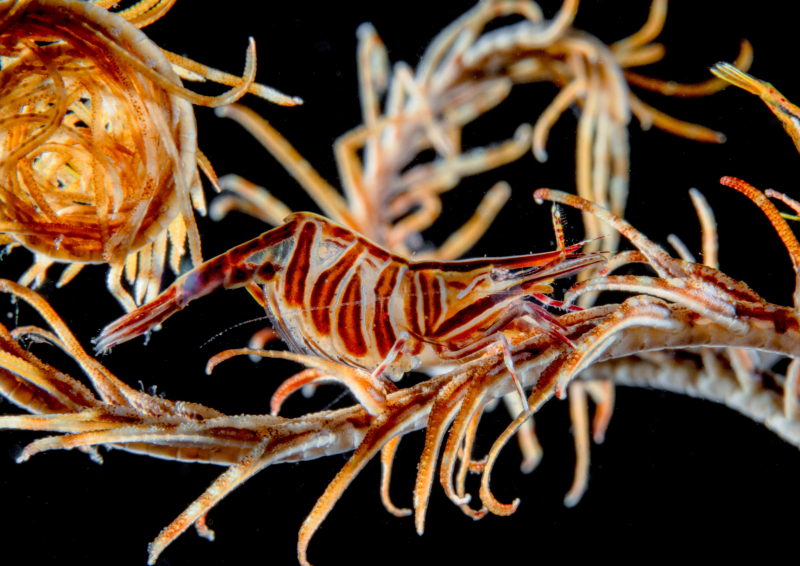
Another very interesting and quite frequent subject is the Trigloporus lastoviza, or streaked gurnard.
Usually, it is surprised motionless on the bottom, but as soon as the underwater photographer approaches it begins to move showing the brightly colored ventral part of the pectoral fins, which it uses as wings to take flight.
It is common to hear the grunt it produces when it is frightened, while it quickly moves away from the diver.
More rare is the encounter with the Torpedo ocellata and the Raja sp., while it is possible to see different species of sole, but also crustaceans such as the striped shrimp Penaeus kerathurus, large mollusks such as the sidegill (turtle) slug Pleurobranchus testudinarius and the umbrella slug Humbraculum mediterraneum.
Our stay at these bathymetric is always limited, so we usually go up the sandy slope, approaching the vertical rocky wall of Punta Lauro, the long side of the J, the promontory that juts out into the sea, where the sand turns back into crushed stones and pebbles.
Here it begins a different habitat, always very interesting, gradually more rocky, where we begin to see many sponges and sessile annelids, but above all, in each ravine, the shrimps Stenopus spinosus and Lysmata seticaudata, some Gnatophyllum elegans, some crustaceans such as lobsters Palinurus elephas, the sponge crab Dromia personata, the Galathea strigosa, the hermit crabs Dardanus arrossor, but also painted combers, groupers, croakers, blennies, gobies, scorpion fish and sea breams of all species.
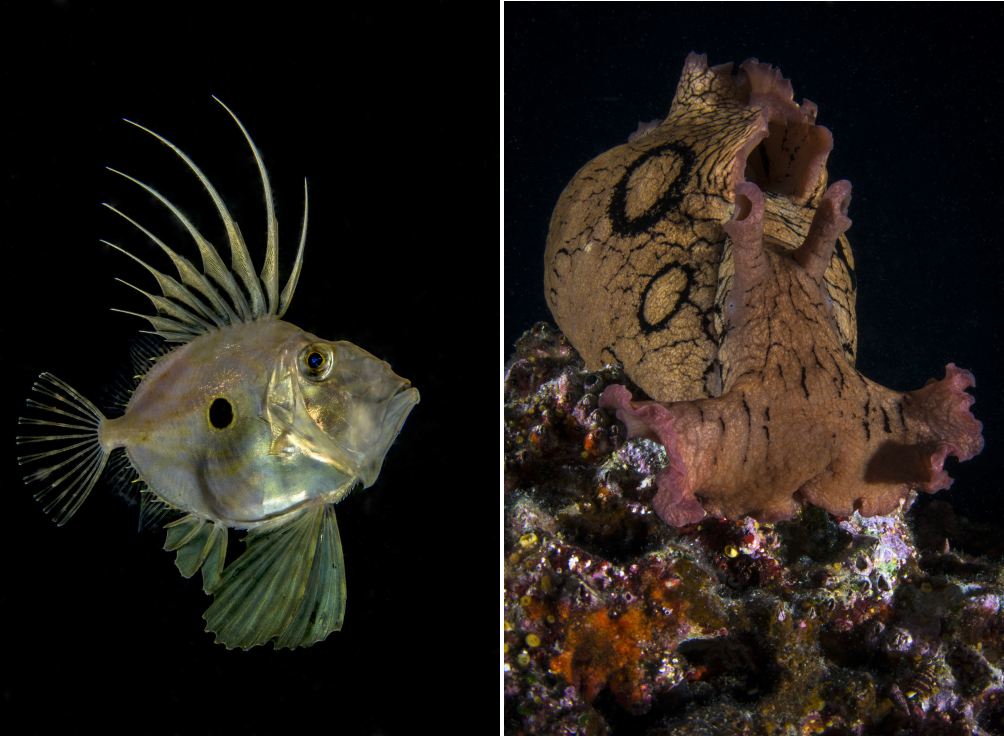
In the small cavities that open along the wall, it is possible to meet some Cymatium like Cymatium (Monoplex) parthenopeum – the giant triton – and the cowrie Luria lurida.
On the wall there are some tufts of Posidonia, among whose leaves it is common to meet the pipefish Signathus acus and some seahorse Hippocampus hippocampus, but also, to the expert eye, it is possible to see very small shells, the Smaragdia viridis, from the bright green color and other small gastropods.
In between the rocks there are many sleeping fish, like the wrasses Symphodus tinca and Symphodus rostratus, parrotfish Sparisoma cretense, but it is also possible to see very small transparent shrimps Pereclimenes sp. among the branches of the sea fans or, amid the arms of the Antedon mediterranea sea lilies, the camouflage Hyppolite prideauxiana.
Our dive is coming to an end, but even in the last few meters of water it is possible to make very interesting encounters on the rocky walls.

There are some large specimens of bearded fireworm Hermodice carunculata and an “alien” but now settled population of spotted sea hares Aplysia dactylomela.
Instead, the encounter with the endemic species Aplysia punctata has now become much rarer.
Next to the beach, among the large pebbles where the big-scale sand smelt Atherina boyeri and the goldlines Sarpa salpa rest in the water column, it is possible to surprise some large mullet Mugil cephalus but also some sea bass Dicentrarchus labrax. It is time to go back up, but during surface navigation to returning to the boat, if you are lucky, you can end the dive by photographing some Loligo vulgaris squid, momentarily attracted by the powerful lamps.

Despite dozens of dives, I always come back to this site with pleasure, because every dive is accompanied by strong emotions.
Obviously there are also normal evenings, or disappointing evenings, but mostly a lot of “super” evenings in which I realize most of the images I use in photographic competitions.
WORDS and PICTURES by Marco Gargiulo

















